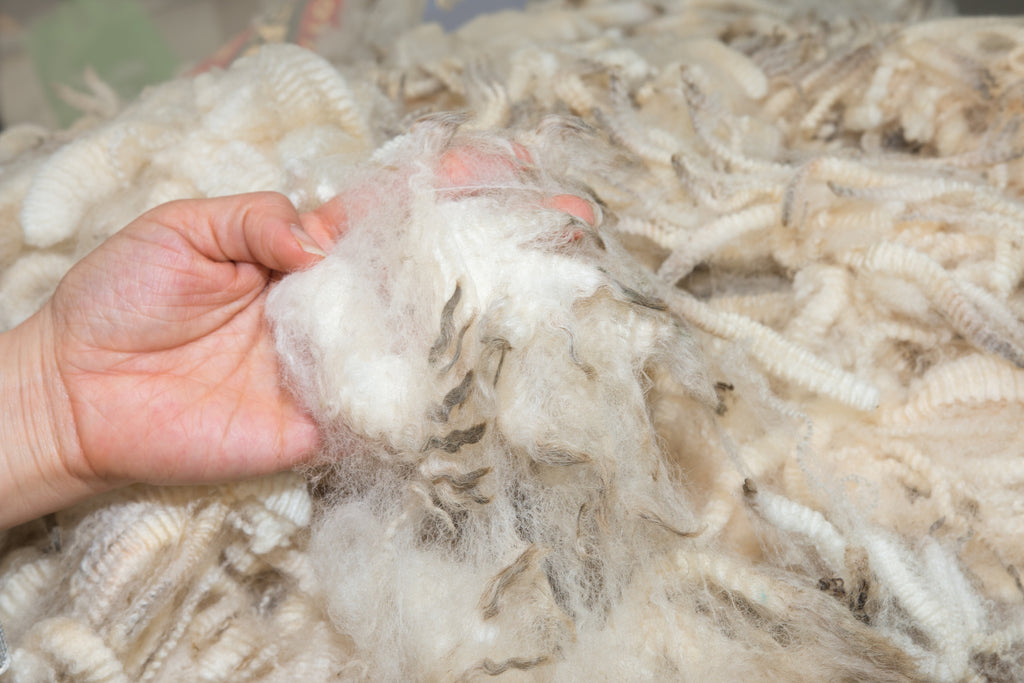Chances are when you hear the word wool, you think of toasty mittens, heavy cable-knit sweaters, or the cozy blanket draped over your shoulders while you bask in the glow of a roaring fire. While the imagery is possibly a bit nostalgic, if you are like the majority of people, you think of wool as a heavy, durable, somewhat scratchy fabric.
Many people believe the discomfort they feel wearing wool indicates an allergic reaction. It may be somewhat surprising to learn that it's unusual for wool to cause skin allergies. The discomfort you felt wearing that itch-provoking sweater gifted to you by your great-aunt Martha, the experience that may have resulted in avoiding wool altogether, has more to do with wool quality than skin sensitivity.
As a textile, wool is commonly misunderstood. Many people don't realize that wool is an all-season fiber that can help keep you cool in the heat and warm in the winter. Outdoor enthusiasts and athletes looking for high performance, lightweight, comfortable garments are turning their attention to merino wool.
The Luxurious Wool of Domesticated Merino Sheep
Merino sheep have been highly valued throughout history for their finely textured coat. During the 13th century, the majority of merino sheep belonged to the nobility and clergy in Spain. These finely-wooled creatures grazed the Southern Plains in the winter and the Northern Highlands during the warmer months. Their resilient coats protected the animals from the coldest winters and most extreme summers. Eventually, merino sheep were domesticated in Australia and New Zealand.
Today, merino wool is well-known for its softness, comfort, and breathability. Garments made with merino wool are reactive, meaning they adapt to body temperature and respond accordingly.
The Significant Advantages of Merino Wool
While some wool can feel harsh against your skin, merino wool is well-known for its comfort and breathability. Merino wool is much softer than common sheep's wool. That's because (measured in microns) the individual strands of merino wool are significantly finer than other breeds. The larger the diameter of the strand, the more course and uncomfortable the garment may feel. Since merino wool is finer than other wool, garments made with merino wool won't scratch, itch, or irritate sensitive skin.
To better understand the properties of merino wool, it may be helpful to compare it to some of the other wool fibers commonly used within the textile industry. Consider the following examples:
Wool from Sheep
Sheep's wool can be shorn from any breed. Most breeds produce wool that has a scaly exterior. While the scaly exterior protects
wool fibers, many people find the rough texture can cause itching. Ordinary sheep's wool can trap air between the garment and your skin and has a reputation for being quite warm, uncomfortably warm at times. Depending on the breed, sheep's wool can be more than 30 microns in diameter. For reference, the average human hair has a diameter of approximately 75 microns.
Lambswool
Garments made from lambswool are softer and smoother than garments made from sheep's wool. That's because lambswool is shorn from young sheep when they are only a few months old. Since only the first shearing counts as lambswool, textiles made from lambswool are commonly more expensive than other types of wool. Lambswool fibers typically measure in at an average of 17.4 microns.
Cashmere
Cashmere is the wool shorn or plucked from goats. Considered luxury wool,
cashmere is stronger, more durable and lighter than lambswool measuring at approximately 19 microns in diameter. Shorn from Angora goats,
mohair has a silk-like texture and is resistant to wrinkles. The hair of the Angora goat is commonly 28-33 microns in diameter.
Alpaca Fleece
The wool of the
alpaca is soft, silky and durable. Like common sheep's wool, alpaca fleece is warm but considerably less rough and scaly than the wool from sheep. Where there is less scale, there is also less itch. Alpaca fleece is available in a variety of natural colors, but can still be dyed. Alpaca wool fibers are typically 20-41 microns in diameter.
Because wool fibers are naturally crimped, wool fabrics have millions of virtually undetectable air pockets. The unique structure of merino wool fibers allows wool fabrics to absorb and release moisture, wicking perspiration. The natural oils make merino fabrics resistant to the elements. The versatility makes merino layers ideal for those who enjoy outdoor sports and recreation regardless of the season.
Selecting Your Ideal Merino Wool Base Layers
Since wool fibers are elastic, wool garments stretch comfortably during wear, easily returning to their pre-worn state. Since they are also resistant to sagging, stretching, and wrinkling, wool garments can maintain their like-new appearance significantly longer than garments made from other natural fibers or synthetics.
When merino wool absorbs moisture, the breathability of the fibers allows moisture to release into the air where there is less humidity. Perspiration evaporates before odor-causing bacteria have the opportunity to multiply. The moisture wicking and moisture releasing abilities explain why so many athletes and outdoor enthusiasts prefer wearing merino wool layers.
While investigating the many layering options of quality merino wool garments, keep in mind that it's the fabric weight that indicates the thickness of the garment. Wool is measured in grams per square meter. The higher the number, the heavier and warmer the fabric. For a better idea of what those numbers mean, consider the following examples of merino wool base layers:
Lightweight Merino Wool (120-200g)
Designed for warm or cool weather,
lightweight merino base layer garments conform naturally to the contours of your body. Lightweight merino base layers are particularly beneficial for those who enjoy physical activities in the great outdoors, like hiking, running, skiing, or bicycling. When temperatures rise from the intensity of your workout or the heat of the sun, wearing lightweight merino layers will keep you cool and comfortable.
Midweight Merino Wool (200-300g)
Midweight merino wool base layers are lightweight enough to be worn as an underlayer but thick enough to be worn as a second layer if you prefer. While merino midweight base layers are thin, they will keep you dry and comfortable in cool to cold weather. Many find merino midweight garments ideal for hunting or late season camping. Winter sports enthusiasts appreciate the moisture-wicking properties that help them retain body heat.
Heavyweight Merino Wool (300g+)
Heavyweight merino wool base layers are the warmest of the three-layer weights, ideal in the cold and snow. Heavyweight merino wool will keep you warm while enjoying your favorite activities, repel moisture, and allow you to move freely without the bulk commonly associated with winter outerwear. Of course, since heavyweight merino wool is still soft and comfortable, there is no reason it can't be worn layered under your winterwear when temperatures drop significantly.
Merino wool layers can be worn as outerwear or as a protective liner. Since the soft, natural fibers conform to your shape, merino layers fit comfortably beneath your clothes. Since merino wool is naturally antimicrobial, since they don't hold odors, you will likely find your Merino base layers need less frequent washing than layers made with synthetic fabrics. That can be a remarkable asset when recreational activities like hiking, fishing, and camping might mean wearing your merino wool garments for longer stretches of time.
Consider the Many Benefits of Merino Wool
Merino sheep can survive in climates in the Southern Alps that would be deadly to other breeds. The natural insulating properties of merino wool make an excellent choice for those braving the harshest winter conditions. There are many other significant benefits of layering your look with merino wool, including the following:
Moisture Wicking
Merino wool is different than other fibers. Most fabrics feel damp after absorbing less than seven percent of their weight in moisture. That means your synthetic layers can feel damp and uncomfortable soon after temperatures rise and you begin to perspire.
Ultra-Absorbent
Merino wool can absorb up to 30% of its dry weight in moisture. When you sweat, merino wool absorbs the excess moisture from your skin. Because merino wool is breathable, moisture is transferred from the fabric to the dryer atmosphere around you. That means moisture is pulled from your skin and released into the environment before you would experience any noticeable effects. When you wear merino wool, you won't feel clammy.
Environmentally Friendly
Merino wool is a natural fiber, a renewable resource. Wool fibers are biodegradable. When merino wool fibers break down after disposal, valuable nutrients are released into the soil. The natural protective coating on merino wool means fabrics are fire and stain-resistant without the use of potentially toxic chemicals.
To indulge your passion for the great outdoors while staying dry and comfortable, consider the many benefits of merino wool. For a quality selection of
merino wool socks, sweaters, tees, and winter accessories, visit
Meriwool Layers. Meriwool base layers are designed for comfort, performance, and affordability.
Written by: Lorri Hollander





